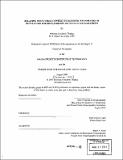Relating behavioral context to acoustic parameters of bottlenose dolphin (Tursiops truncatus) vocalizations
Author(s)
Thomas, Rebecca Elizabeth
DownloadFull printable version (17.47Mb)
Other Contributors
Woods Hole Oceanographic Institution.
Advisor
Peter Lloyd Tyack.
Terms of use
Metadata
Show full item recordAbstract
This thesis presents methods to analyze the function of vocalizations of the bottlenose dolphin, Tursiops truncatus. The thesis uses the social interaction as the basic unit of analysis, and maintains a deliberate focus on quantitative and replicable analyses throughout. A method for determining identity of the vocalizing animal in a lagoon was developed. This method combined passive acoustic localization with video sampling to determine which animal vocalized. It fills an urgent need for unbiased identification of vocalizations of undisturbed dolphins where details of social interactions can be followed without affecting the behavior of the subjects. This method was implemented in a captive lagoon with 6 dolphins: two adult females, their two male calves, and a juvenile male and a juvenile female. This thesis also reviews the current state of analysis of the bottlenose dolphin acoustic repertoire, highlighting the need for a detailed, quantitative, and consistent study of the entire vocal repertoire. It does not attempt to do a comprehensive repertoire study, but uses several new quantitative methods to parameterize vocalizations and relate these to behavior from dolphins. Vocalizations within the lagoon tended to occur around the time of onset of behaviors produced by the focal dolphin. A comparison of vocalizations during affiliative and agonistic interactions revealed that the association of group vocalizations with the behavior of a focal animal was related to agonistic but not affiliative interactions. Using the localization/video method, vocalizations in a time window around submissive behaviors were localized and classified as having come from either dolphins engaged in the interaction or dolphins not engaged in the interaction. Vocalizations were emitted by interactants more often than expected, and by non-interactants less often than expected. Use of different vocalization types was found to vary depending on the context of the agonistic interaction. In addition, the sequence of vocalizations with respect to behaviors within the interaction mattered, with more vocalizations occurring after than before submissive behaviors. These results demonstrated that group-based analyses of vocalizations are insufficient and one must use techniques designed to focus on the level of the interaction in order to study communication and social behavior in dolphins.
Description
Thesis (Ph. D.)--Joint Program in Oceanography (Massachusetts Institute of Technology, Dept. of Biology, and the Woods Hole Oceanographic Institution), 2001. Includes bibliographical references.
Date issued
2001Department
Joint Program in Oceanography; Woods Hole Oceanographic Institution; Massachusetts Institute of Technology. Department of Ocean EngineeringPublisher
Massachusetts Institute of Technology
Keywords
Biology., Joint Program in Oceanography., Woods Hole Oceanographic Institution.